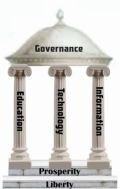
Real Reform, Part 3: The Bureaucratic Cat Burglar
The cat burglar creeps quietly into his target after doing extensive surveillance and steals the planned target. If the burglar does the job well, there is no evidence of a theft and it may not be detected for weeks or even months, depending on the target. The bureaucracy is like the cat burglar, clandestinely robbing the mark of wealth and leaving little trace.
This is the third in a series on real reform and builds on Real Reform, Part 1 Introduction and Real Reform, Part 2: The Allosaurus In The Room. This part focuses on bureaucracy. Since the Wilsonian reforms, it has transmuted from a spoils system to an unelected, unaccountable fourth branch of government. See the list of blogs on the bureaucracy for details and analysis.
Wilson and other reformers designed these reforms to do two things. Implement the principles of scientific management and to eliminate the spoils system/nepotism/patronage through the Civil Service Act of 1883. In a report, the Congressional Research Service states, “Federal employees receive statutory protections that differ from those of the private sector, including more robust limits on when they can be removed or demoted. Although several laws apply to various aspects of the federal civil service system, the primary governing framework is the Civil Service Reform Act of 1978 (CSRA), as amended. The CSRA created a comprehensive system for reviewing actions taken by most federal agencies against their employees, and the act provides a variety of legal protections and remedies for federal employees.”
Sometimes, however, the cure is worse than the disease. I suspect this is the case with the bureaucratic reforms. The references below detail:
- Regulatory capture. Bureaucrats collude with the companies they regulate for fun and profit.
- Political/Policy capture. There is no established theory on this one. I developed it in the series referenced below. There is a parallel though, that has some established research and theory: street-level bureaucracy. This research shows that street-level bureaucrats, those working daily with the public normally on social services, education, and security, have a great deal of discretion in how they apply policy and arguably make their own policy with their actions. I suspect this behavior is moving into all areas of the bureaucracy. We perhaps saw this in action with General Milley’s interaction with China and waning days of the Trump administration.
- Academic capture. Academics weigh in and shape both policy and execution based on the theories they develop and the research they conduct and publish. They may work closely with bureaucrats, especially those with similar political agendas, to sway public opinion. Social media makes easy and effective for those that establish and propagate popular memes.
- Criminal capture. I suspect this has been around since the 1820s or earlier, when Gordon S. Wood noted in The Radicalism of the American Revolution, the founders of the Republic were increasingly dissatisfied with the course of the Republic. Perhaps the best and most dangerous example are trafficking networks (drugs, human, weapons) colluding with bureaucrats. This collusion protects the networks and drives up the cost of the goods and services they provide. Think about the war on drugs, fentanyl, and prostitution. Many of these are part of the explosion of illegal migration into the US. This could also include the criminal capture of national intelligence and law enforcement operations to further criminal activity and promote targeted causes. A low-level example is states and school boards using the Justice Department and the FBI to brand parents that disagree with social justice movements terrorists. Even the Roman Catholic church is now seen as a terrorist organization.
We need to remember the FBI, Justice Department, Education Department and other departments and agencies are part of the vast, sprawling, unregulated and largely unaccountable bureaucracy. But there is another side as well that many forget about.
There is a large congressional bureaucracy with the personal and committee staffs. These bureaucrats are almost unaccountable and Congress can largely hire and fire as they choose. The Congressional Research Service, in a report on congressional staffs, wrote: “Members of the House and Senate establish their own employment policies and practices for their personal offices.” That may sound fine until think about massive 5,000 page bills the staffers write that few congressional representatives have the time or the inclination to read. Recall Nancy Pelosi’s comment, “we have to pass the bill so that you can find out what is in it, away from the fog of the controversy.” This is absolutely not how a responsible government accountable to the electorate should work. It also fuels the weaponisation of federal policy to support the objectives of the entrenched politicians and bureaucrats.
These actions are like the cat burglar. The bureaucracy and staffs are largely anonymous and the theft is even harder to detect than a necklace missing from a safe. The evidence is the exploding federal deficit, the growth in the bureaucracy and a reduction of overall quality of living. See Part 7: The Great Society and Critical Thinking and Policy: The Wars on Drugs and Poverty for examples. Programs are increasingly expensive, less effective, and hard to end.
So, what can we do, shrug our shoulders and say the problem is too hard or engage in real reform? Here are some potential reforms:
- Reform the Civil Service. Provide for easier methods to terminate non-performing employees, better controls over hiring to ensure only highly qualified people with proven skills are hired. Revise to make it easier to fire non-performing employees.
- Exempt Senior Executive Service (SES) and GG-15s from the civil service regulations or add different policies to govern them. These employees are critical for policy development and execution control.
- Cut the civil service by at least half, across all departments, to include Defense. Focus on policy development and quality control of policy execution. Move positions into federal contractors. This makes it easier to terminate employees if programs are complete or ineffective or the employee is non-performing.
- Eliminate the Education Department and other departments that do not directly support the Preamble to the Constitution: “We the People of the United States, in Order to form a more perfect Union, establish Justice, insure domestic Tranquility, provide for the common defence, promote the general Welfare, and secure the Blessings of Liberty to ourselves and our Posterity, do ordain and establish this Constitution for the United States of America.” As part of this process, conduct a candid assessment of all department’s programs to validate alignment and ensure they deliver the intended results.
- Eliminate the “double-dipping” where retired military serve in government positions, getting their retirement and the government pay and then a second government retirement.
- Make the congressional staffers subject to the same laws and regulations that govern the executive bureaucracy.
Meaningful reform requires sound critical thinking and open and objective analysis. Use the concepts of policy development in Critical Thinking and Policy Development and Analysis to govern the analysis. Let’s face it. With enormous deficits and proven bureaucratic problems we must conduct deep and meaningful reform.





